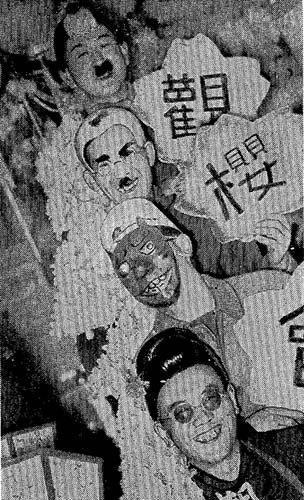
Young people in suits reserve zones in the morning for an evening hanami party in Ueno Park. (March 31, 2004)
13:00 JST, April 9, 2022
The practice of hanami, literally “blossom viewing,” is said to have originated during the Nara period (710-784) when people went out to appreciate plum blossoms. Cherry blossoms became more popular as the object of flower appreciation in the Heian period (794-late 12th century.)
What used to be entertainment only for the aristocracy gradually spread to commoners. Classic rakugo storytelling depicts common people in the Edo period (1603-1867) having parties under the cherry blossoms.
An article in The Yomiuri Shimbun dated March 31, 1875, reads: “Women disguised as men and men as women are often seen around the time of cherry blossom viewing. You must be careful because if the police catch you in such a disguise, they will take you to a police station.”
Apparently, not only did people drink and go wild at cherry blossom viewing parties, but they also masqueraded in costume in those long-ago times. It was just like Halloween nowadays.
Full of drunks
An article in the paper dated March 31, 1922, reported that the Metropolitan Police Department issued instructions to police stations in Tokyo about cherry blossom viewing parties. “Hanami party attendees must not wear unusual costumes. It is important to know the rules of cherry blossom viewing parties.”

Costumed revelers in fancy dress make funny faces for the camera at a cherry blossom viewing event. (Carried in the April 11, 1936, issue of The Yomiuri Shimbun)
In addition to forbidding people from wearing disguises, the police dealt with hanami events as if they were demonstrations, requiring groups planning them to report to a police station the date, time, number of people and course of the cherry blossom viewing.
Why have Japanese people continued to get drunk, cause mayhem and behave in an ugly fashion under the cherry blossoms? Criticisms and insights by intellectuals have been carried in the paper from time to time.
An article in The Yomiuri Shimbun dated April 17, 1929, reported the view of a women’s activist with the headline, “Mayhem at hanami parties reflects barbarism of Japanese.” This headline sums up the whole article.
In an article on the culture page on April 25, 2003, Tadashi Karube, who was then an associate professor at the University of Tokyo, writes, “The various changes and unexpected transformations of cherry blossoms are what make the flower so attractive.”
I lived on the second floor of an apartment building by a river lined with cherry trees for about 10 years. In spring, the area outside the window was filled with cherry blossoms in full bloom. Some may feel envious hearing this, but if you got too close, there was nothing beautiful about the scenery, it was just plain white.
Like a heavy snowfall in a city, the rows of cherry trees transform the landscape violently and forcefully for a short period of time each year. Amid the hustle and bustle of the city outside my window, I wondered if it was the abrupt and extraordinary nature of this change that would free people’s minds.
Sino-Japanese War
During the height of the second Sino-Japanese War, when people’s activities were restricted, there was a Yomiuri Shimbun article on March 5, 1941, with the headline, “Bringing daytime liquor to hanami approved.”
Although the sale of alcoholic beverages was regulated before 5 p.m., the Home Affairs Ministry decided to tacitly allow people to drink during the daytime if they brought their own alcoholic beverages for cherry blossom viewing, according to the report.
“The ministry strictly prohibits people from disguising themselves in costumes and causing mayhem even if they bring their own alcohol at these times,” the paper reported. The article says that even the authorities had to take into consideration the public’s desire to enjoy cherry blossoms.
When World War II was over, people went out to see cherry blossoms again. Two years after the end of the war, an article on April 14, 1947, records, “The number of people who went out to see the cherry blossoms yesterday on Sunday was about 300,000 in Ueno, and more than 1 million visited viewing spots along railways, a new record since the end of the war.”

Prime Minister Shigeru Yoshida chats with the wife of the U.S. ambassador and others at the annual cherry blossom viewing party at Shinjuku Gyoen park in Tokyo. (Carried in the April 18, 1953, issue of The Yomiuri Shimbun)

A person who appears to be drunk is cared for in Ueno Park in Tokyo. (Carried in the April 10, 1950, issue of The Yomiuri Shimbun)
‘Place holding’ rampant
It was not until the 1980s that the practice of saving a spot by laying out picnic blankets ahead of time began to be reported in newspapers. In the Yomiuri Shimbun edition issued on April 13, 1984, there was an article headlined, “Hanami etiquette: Extremely annoying, trash left behind, place holding, karaoke.”
The report said the irritating practice of place holding was said to be rampant in Ueno Park, with some visitors ignoring “no trespassing” signs and putting up ropes to take up the equivalent of more than 20 tatami mats of space.
The paper’s evening edition on March 27, 1993, reported that young people who appeared to be newly hired employees were securing spots for their companies’ hanami groups the same day, a Saturday.
Today, workplaces where employees gather on weekends to hunt for hanami spots and have a party are not likely to be favored by employees.
Foreigners perplexed
Many foreigners seem to have felt it was bizarre to see the usually quiet and serious Japanese behave as if they were totally different people when it came to hanami.
The 1999 issue of the “Japan Watch” column of the daily introduced the opinions of foreigners about Japanese behavior at the events.
Most opinions were critical, with a 24-year-old Russian woman who had lived in Japan for five years saying: “It was both enjoyable and perplexing … People ate their bento in an orderly manner, and soon many fell asleep under the trees while others did karaoke without talking to each other.” It was also a time when TV shows with foreigners talking about the things that seemed strange about Japan were gaining popularity.
Down through the ages, however, the atmosphere continues to change. An article in The Yomiuri Shimbun dated March 25, 2016, reported: “Recently, increasing numbers of foreigners have come to enjoy Japanese-style hanami parties under the trees. Travel agencies and local facilities at such tourist spots are scrambling to keep up with such demand.”
This may be the result of the government’s policy to attract more people to Japan, or it may be because more people are becoming interested in hanami through online media and anime.
The article also states, “Some recent posts on Weibo, China’s version of Twitter, read, ‘Japanese people are singing and eating bento meals. It looks fun,’ and ‘Cherry blossoms at night are beautiful.’”
This year’s hanami events are not the same as before the outbreak of the novel coronavirus. But the flowers bloom, no matter what is going on in the world.

Ueno Park is closed to traffic amid the spread of the novel coronavirus. (March 28, 2020)
"Society" POPULAR ARTICLE
-

M4.9 Earthquake Hits Tokyo, Neighboring Prefectures
-

Israeli Tourists Refused Accommodation at Hotel in Japan’s Nagano Pref., Prompting Protest by Israeli Embassy and Probe by Prefecture
-

M7.5 Earthquake Hits Northern Japan; Tsunami Waves Observed in Hokkaido, Aomori and Iwate Prefectures
-

Tsukiji Market Urges Tourists to Avoid Visiting in Year-End
-

M5.7 Earthquake Hits Japan’s Kumamoto Pref., Measuring Upper 5 Intensity, No Tsunami Expected
JN ACCESS RANKING
-

Keidanren Chairman Yoshinobu Tsutsui Visits Kashiwazaki-Kariwa Nuclear Power Plant; Inspects New Emergency Safety System
-

Imports of Rare Earths from China Facing Delays, May Be Caused by Deterioration of Japan-China Relations
-

University of Tokyo Professor Discusses Japanese Economic Security in Interview Ahead of Forum
-

Tokyo Economic Security Forum to Hold Inaugural Meeting Amid Tense Global Environment
-

Japan Pulls out of Vietnam Nuclear Project, Complicating Hanoi’s Power Plans






















